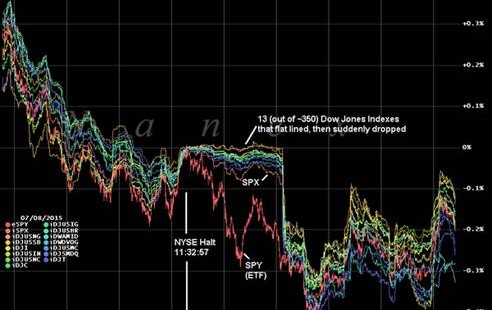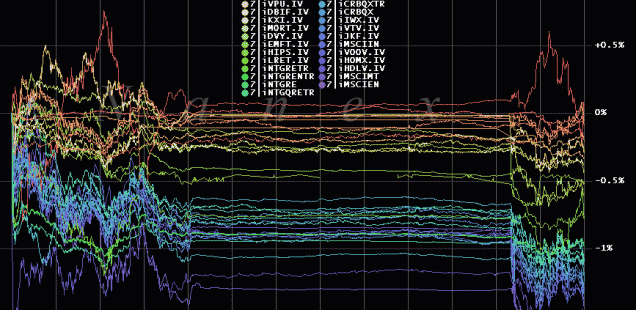10
Jul, 2015
10
Jul, 2015
The NYSE Outage Exposed That Equity Indexes Are Not Being Calculated Accurately
There is no question that the NYSE software glitch which shut down the exchange for over three hours on Tuesday has been one of the most covered events by the financial media this year. While we have read and contributed to many of these articles (including this CNBC interview), there was one significant piece of news from this event which seems to have escaped most articles – the NYSE glitch caused most indexes to be calculated incorrectly starting at 11:32am on July 8th. The reason why this occurred is because most indexes use trade data from ONLY the primary listing exchange. They ignore trades done on the other 10 exchanges and they ignore all off-exchange volume when calculating their index. If this sounds familiar to you, it’s because we identified this problem back in 2011 when we wrote a white paper title “Phantom Indexes”.
“The Phantom index problem appears to be another unintended consequence of the SEC’s Reg NMS. Prior to 2007, approximately 80% of NYSE listed stocks traded on the NYSE and the majority of stocks in the S&P 500 and the DJIA (the two most watched indexes) were NYSE listed stocks. In 2007, Reg NMS resulted in the equity markets becoming extremely fragmented, spreading trades amongst a variety of competing market centers.
Almost overnight, NYSE’s market share of trading dropped from 80% to less than 30% as faster, cheaper competitors captured share. Indexes, which were being calculated intraday based on 80% of all trades, began being calculated based on less than 30% of all trades. Owners of the major indexes, however, have not changed what data they capture to reflect this new paradigm.”
Our white paper from 2011 details the exact problem but let’s just recap what happened on Tuesday:
– At 11:32am, the NYSE halted trading on their exchange of all symbols
– At 11:51am, S&P Dow Jones Indices switched to the Composite Tape for NYSE listed stocks for calculating intraday index levels.
Take a look at the below chart from Nanex which illustrates the action in some of the S&P Dow Jones indexes during the 19 minutes where the indexes had no data:
The flatline beginning at 11:32am and lasting to 11:51am shows that these indexes were not being calculated correctly. Even worse were some non S&P Dow Jones indexes which never switched to composite data:
Why would index providers choose to calculate their indexes based on only a subset of data which represents less than 25% of the trades occurring?
We’re not sure but we can only speculate on a couple of possibilities:
1 – Cost – The index providers did not want to pay the other exchanges for access to their market data
2- Incompetence – The index providers never adjusted their calculation methods after Reg NMS was implemented.
Does it really matter that intraday indexes are not being calculated correctly?
Some folks like Matt Levine from Bloomberg, who referenced our white paper in this article , think that intraday index values don’t seem to matter much. Matt says:
“The intraday index price is purely informational; nothing turns on it. As we saw yesterday, index exchange-traded funds seem perfectly able to find the “right” price themselves, based on composite trading, without worrying about little glitches like a NYSE shutdown.”
We disagree with Matt and believe that all investors who rely on these index values to help them make investment decisions (and pay vendors like Bloomberg for this information) should be given the most accurate and complete information.
Either way, whether you think it matters or not, there is a simple solution to the problem: index providers should use data from the Composite Tape to calculate their index values. Back in 2011, we ended our Phantom Index white paper with this statement:
“In a post Reg NMS world, fragmentation amongst market centers has reduced the amount of trades that occur on the primary exchanges. The primary market alone is no longer a complete enough source of data when calculating an index value since it represents only about one in four trades. Index suppliers must adjust their methodology to accurately reflect all trades intraday in a timely manner.”
We’d like to reiterate that statement and call on all index providers to adjust their calculation methodology so that all investors are seeing the most accurate values. We think that advocates of the current fragmented market should also call for these changes. After all, don’t they want the indexes to reflect their perfectly fragmented world and not just prices from a single exchange?



